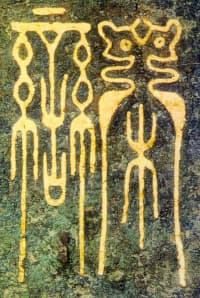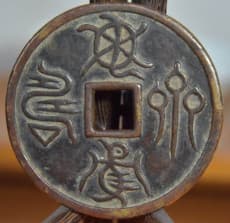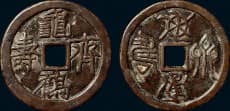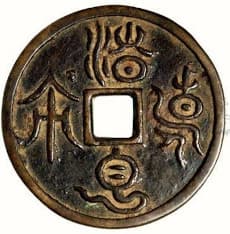Chinese Charms and Bird-Worm Seal Script
One of the oldest Chinese scripts originated more than 2500 years ago in a region of southern China. The characters of this Chinese script are very stylish and resemble birds and insects. This script is known as Bird-Worm Seal Script (鸟虫篆).
Because of its attractive style, Chinese kings and nobles of the Warring States period (476 BC - 221 BC) in particular liked using bird-worm seal script on their personal seals and as decoration on important objects such as weapons.
A few Chinese charms from later dynasties also have inscriptions written in bird-worm seal script and will be discussed below.
Bird-Worm Seal Script

with Bird-Worm Seal Script
inscription
During the Warring States period, China consisted of a number of small states. There was no standard writing system and each state used characters that, while different, were still similar to those found on the oracle bones (甲骨).
The states of Wu (吴), Yue (越), Chu (楚), Cai (蔡), Xu (徐), and Song (宋) were located in the south where the people strongly believed that all of nature was inhabited with spirits. This belief was also reflected in the style of their written characters. The characters resembled birds and insects.
Some characters were mainly written in a style that resembled birds and is referred to as Bird Seal Script (鸟篆). Other characters were written in a style resembling worms and is known as Worm Seal Script (虫篆). Collectively, these types are known as Bird-Worm Seal Script.
The image shown here is an example of bird-worm seal script. The gold-inlaid characters are on a bronze dagger-axe (ge 戈) found in the tomb of Song Gong Luan (宋公欒) who was the 27th Duke of the State of Song. He died in 451 BC.
The inscription on the dagger-axe has six characters. Two of the characters are shown here. The character on the right is song (宋), for the State of Song, and the character on the left is luan (欒), which is the third character in Song Gong Luan.
Although its popularity waned in the centuries that followed, bird-worm seal script continued to be used as a decorative script due to its strong aesthetic appeal.
Examples of Chinese Charms Written in Bird-Worm Seal Script

Bird-Worm Seal Script
Shown at the left is a Chinese charm that recently appeared in a Chinese coin forum.
The charm is believed to have been cast during the early part of the Song dynasty (宋朝 960-1279) and the four-character inscription is written in the ancient bird-worm seal script.
The inscription is read in the following order: top, bottom, right, left.
As already mentioned, the main characteristic of this script is that the characters resemble animals. The character at the top resembles a tortoise (gui 龟) and, of course, is the Chinese character in this script for "tortoise".
The character below the square hole is easily recognized as a bird and in this case is specifically a "heron" (he 鹤).
The character to the right of the hole looks like three "worms". This symbol (qi 齐) expresses the meaning of "are equal to" or "be the same as".
The character to the left of the hole, which has a s-shaped "worm" running through it, is the Chinese character shou (寿) meaning "longevity".
The Chinese have traditionally believed that both the tortoise and the heron live for a long time.
Therefore, the inscription on this charm can be understood to be "Live as long as the tortoise and the crane" (gui he qi shou 龟鹤齐寿).
The reverse side of this charm is blank with no characters.
This charm is 6.4cm in diameter, 4mm thick, and weighs 71.1 grams.

both Bird-Worm Seal Script
and Regular Script
At the left is a different version of the charm. This version has the inscription written in bird-worm seal script on one side (right image) and the same inscription written in regular script (楷书) on the other side (left image).
The charm is believed to have been cast during the period of the Yuan (元朝 1271-1368) and Ming (明朝 1368-1644) dynasties. This charm is slightly smaller at 5.81cm in diameter and was sold by China Guardian Auctions in 2014 for about $1,780 (11,500 RMB).
Similar Charms Written in Tadpole Script
There is another form of ancient Chinese script that is similar to the bird worm seal script we have been discussing. This script is known as "tadpole script" (ke do wen 蝌蚪文) because the characters resemble tadpoles.

Tadpole Script
The tadpole script inscription on the Confucian charm shown at the left reads qing bai chuan jia (清白传家) which translates as "Pureness handed down in the family".
"Pureness" refers to moral integrity, filial piety and the other Confucian values which were revered throughout Chinese history. This pureness to Confucian values was handed down from generation to generation.
The image of this Confucian charm can be found on Chinese websites but the detailed specifications of the charm are not given. The charm, however, would date to the Song dynasty.
For those interested in the background of this type of charm, I have written an article which discusses in detail the historical source and explanation for charms written in tadpole script with the inscription "Pureness handed down in the family".
Also, there was a television show broadcast in China which discusses rare varieties of Chinese charms written in Tadpole Script. The show is in Chinese but even if you do not understand Chinese you may find the video interesting.
Finally, very few Chinese charms have been discovered written in bird-worm seal script and authentic specimens are quite scarce. However, there is at least one type of Korean charm that is also written in bird-worm seal script. For those interested, please see "Korean Charm Teaches Chinese" for a detailed discussion.
